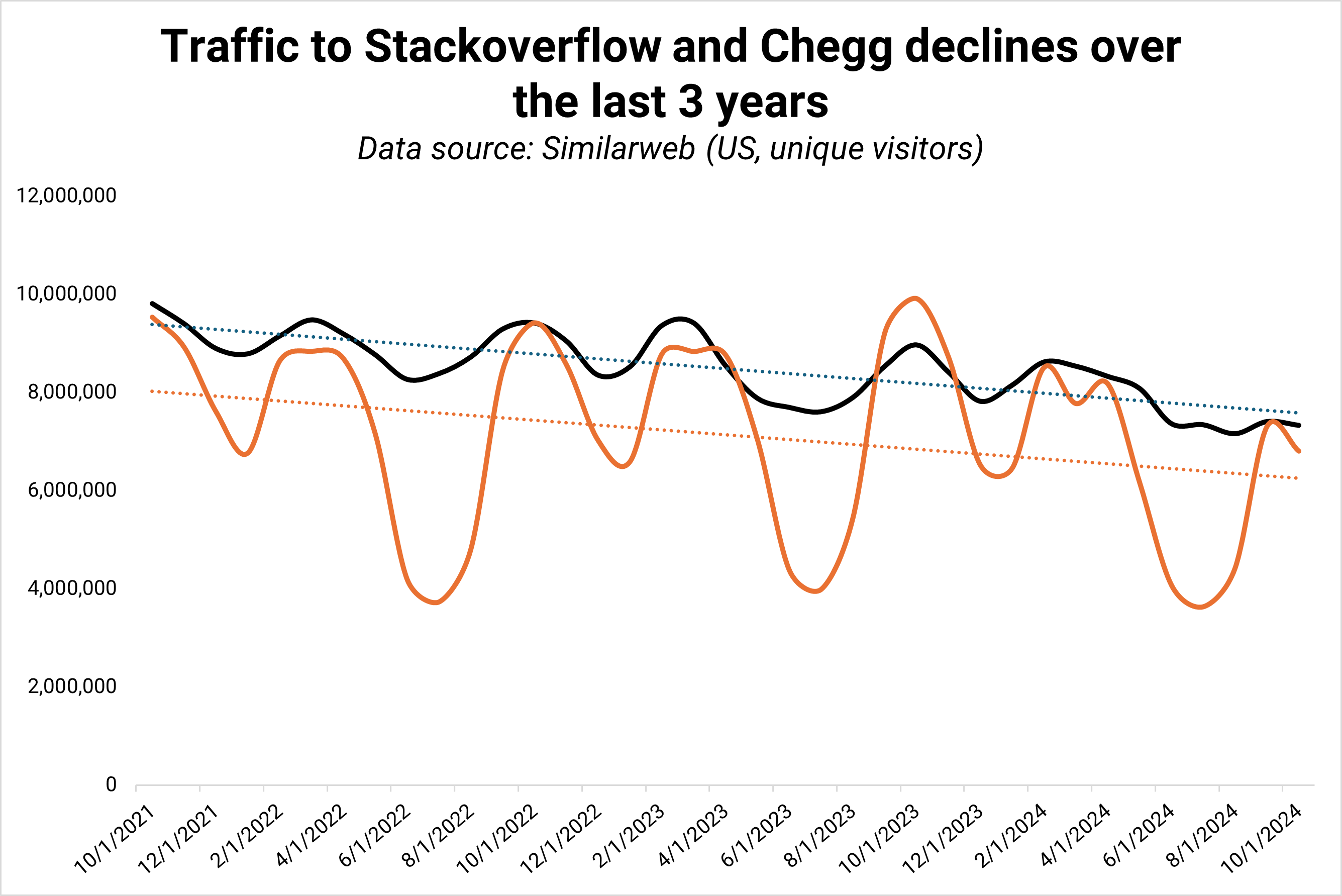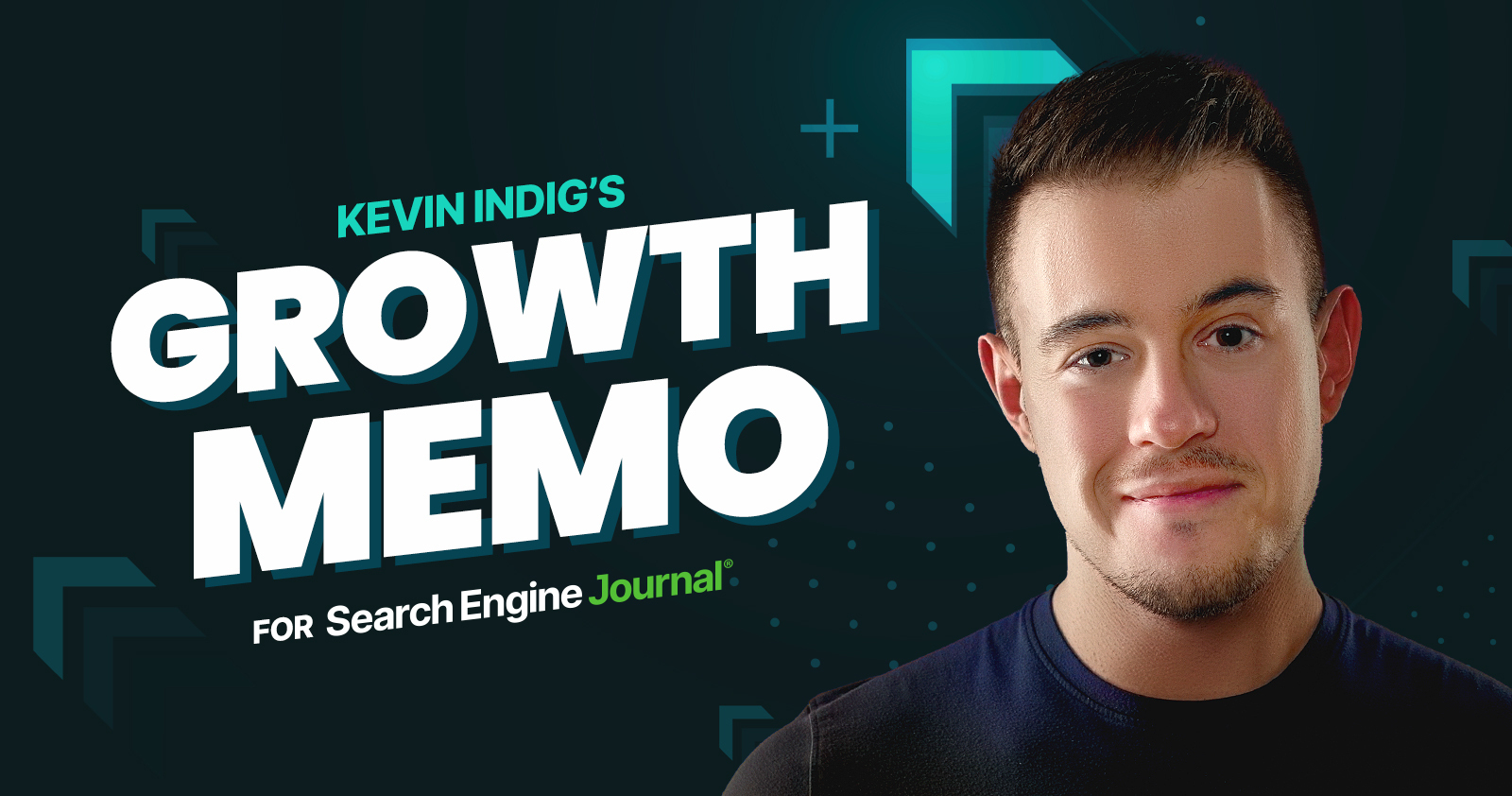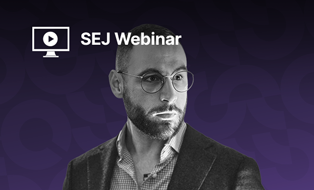Last week, I relived an experience I first had in 2016: I went to bed thinking I’d wake up to our first female president but woke up to Trump.
One personal takeaway from the election result that’s very transferrable to organic growth is the mismatch between perception and reality. You think you’re connected to reality, but you’re actually not. A filter bubble.
Confirmation bias is the juice that gives filter bubbles life.
The most dangerous bias is being married to tactics or beliefs that have worked for a long time but have lost their efficacy.
A question I’ve been thinking about a lot in the last two years as AI disrupts our industry head to toe: Where am I too romantic about my work? What tactics have become empty bullets?
Boost your skills with Growth Memo’s weekly expert insights. Subscribe for free!
Lost Efficacy
 Image Credit: Kevin Indig
Image Credit: Kevin IndigStackoverflow and Chegg have suffered from a structural decline in the last three years. Their business model worked until it didn’t, proudly presented by AI.
In the same vein, many content marketers and SEO pros still operate like it’s 2014: Pump out evergreen content prioritized by search volume and supported by masses of mediocre backlinks.
You might feel a cocktail of “still works” and “not new” reading this line, but in my work as an advisor, I still see a lot of money flowing into this stuff. Too much.
The most common response after months of work and tens of thousands of dollars invested is “SEO takes time.” Just wait and spend more money. But the returns never come. The consequence: wasted effort and eroding trust in leadership.
I see five filter bubbles in organic growth:
- Evergreen-focused content marketing.
- Direct-response mindset.
- Low-brand organic traffic.
- Volume link building.
- Forgoing customer research.
Content marketing is still well and alive but not in its original form.
Content Marketing Institute’s 2025 B2B report shows that over half of content marketers struggle to measure the results of their efforts and create content that leads to the desired action.1
User behavior is complex and not linear. But when so many smart people struggle to measure impact, it raises the question of whether the problem is technology and resources or efficacy.
It doesn’t help that Google updates create instability. The way I phrased it in (Hard)Core Algorithm Updates:
“Google updates have become unpredictable instead of enforcing a straight line, which makes SEO less predictable as a channel.”
SEO can still be very ROI-positive, but it cannot succeed in a silo anymore.
Attention shifted from the open web to (social) content platforms like YouTube and LinkedIn. The soundbite that 40% of Gen Z use TikTok for Search instead of Google is not a feature issue but a generational shift.
Content platforms are all about engagement (see more), not a direct response (click out). Many leaders make the mistake of expecting transactional referral traffic and get disappointed, eventually leaving the playing field for others.
When you look closely, all popular platforms are about engagement.
Google is the last holdout, but AI turns Search into an engagement channel that is not incentivized to send users away because the answer is right there. Users click out to validate and verify but not to get information in the first place.
Engagement leads to awareness, and Google rewards brands that get a lot of searches with more non-branded searches.
If Google’s algorithms taught us one thing over the last two years, it’s that massive amounts of non-branded organic traffic need to be carried by brand (traffic).
In Favoritism, I showed how Google gives brands more visibility in most verticals. “Brand” has replaced links as a factor. They still matter, but not in volume. The ones that are hard to get have the biggest impact. How do you get them? Brand building activities:
- Funding rounds lead to TechCrunch backlinks.
- YouTube advertising leads to homepage links (if the product is good).
- Good reputation leads to publisher coverage.
None of this works without deeply understanding who you want to engage with.
The sad reality is that most marketing teams have no idea where to find customer research or have built ties to customers because performance marketing (metrics) worked too well for too long.
But now that brand is actually important again because it drives engagement (and vice versa), content needs to be inspired by the source: customers.
New Formula
 Image Credit: Kevin Indig
Image Credit: Kevin IndigThe formula for preventing a November 6 surprise in organic growth: connection + authenticity + surround sound.
Connection
The fact that NotebookLM’s traffic surpassed Perplexity in the U.S. when it launched its podcast feature shows the power connection.
Whether you sell to consumers or companies, you sell to people, and the number one thing we crave is connection.
The reason podcasts and Reddit are so successful is because they’re connecting. The opposite of connection is scripted corporate content.
Nobody is interested in generic, faceless content – especially when Gen AI can give an equally good or better answer. But first-person, high-expertise content resonates.
Hearing someone in your ear is much more intimate than reading (as I’m writing this, I painfully remind myself to pivot to video).
An estimated 100 million U.S. Americans listen to a podcast at least once a week.2
The projected advertising market value of $2 billion in the U.S. and $4 billion globally in 2024 seems too low when comparing the 48 million views to date Trump’s three-hour podcast with Joe Rogan amassed with the average 3.5 million daily views Fox gets.3
The growth of people appending “Reddit” to their queries had grown for years before Google lined the domain up with visibility that matches demand.
Many don’t like the visibility Reddit gets in Search, but it’s a direct result of the desire to connect instead of browse websites.
Marching orders: There’s no doubt companies should invest in Reddit and podcasts.
Whether it’s advertising or organic campaigns, starting your own company podcast is not as important as the question of how you can connect with your audience on these platforms. A few ideas:
- An unpolished video of the founder telling the story of the company.
- AMAs or behind the scenes on Reddit.
- Host-read podcast ads.
The foundation is a deep understanding of what your customers value, their problems, and how they perceive you.
Authenticity
Creating content on engaging channels is not enough. It needs to be “authentic.” But what does that even mean?
I like Seth Godin’s definition: It’s about consistently proofing that who you are is who you say you are. It’s very hard to sell a fake version of yourself in a three-hour podcast. That’s why the format works.
We call a brand or a person authentic when they’re consistent, when they act the same way whether or not someone is looking. Someone is authentic when their actions are in alignment with what they promise.4
As sad as it is, Trump’s personality was more important than his policy to voters. Both candidates got very active on the content platform, knowing that 4/10 young adults get their news from TikTok and brands with a strong approach to social media are 8x more likely to exceed revenue goals by +25% than competitors with low social maturity.5
But Trump gained double as many followers and hashtag posts than Harris by recording videos with Gen Z influences like Adin Ross or Logan Paul.6
Elections, like company Growth, don’t fail or succeed because of one thing, but social media is a gateway to consistently show up with the same story.
Marching orders: Extend brand guidelines beyond just the written word or usage of the company logo.
There needs to be a script for story points, messaging, and audience personas.
Identify employees who have what it takes to be the face(s) of the company on channels like YouTube or Reddit and put them front and center.
Surround Sound
When I speak at conferences, I usually stare into a sea of laptops or smartphones. I do the same when I watch a presentation. We’re constantly distracted and semi-listening.
As a result, connecting and being authentic is not enough to win; you need to be everywhere.
Trump saying crazy things gets him free exposure, and it has worked for him.
HubSpot has one of the most visible blogs in SaaS, but it bought newsletters and built a podcast network for a good reason: to create surround sound.
As the traditional media industry crumbles, companies build small media empires to market themselves.
Marching orders: Figure out where your audience is and double down. YouTube and podcasts are no-brainers. Be smart about content repurposing. Stay on story > stay on brand.
On Target
Today’s Growth landscape is fragmented and disrupted. Strategies that once guaranteed growth may now lead us astray.
Just as the 2024 election revealed a gulf between perception and reality, many in marketing and SEO are trapped in outdated tactics that feel comfortable but yield diminishing returns.
As AI reshapes content, the winning formula is clear: genuine connection, unwavering authenticity, and relentless surround sound forged on deep audience knowledge.
The question is no longer whether organic growth evolves but how rapidly you’ll adapt.
1 B2B Content Marketing Benchmarks, Budgets, and Trends: Outlook for 2025 [Research]
2 Podcast Listening Hits Record Highs
3 U.S. Podcast Advertising Revenue Study
5 More Americans – especially young adults – are regularly getting news on TikTok
6 Trump’s savvy memes and flashy edits trounce Harris in war for precious views from young voters
Featured Image: Paulo Bobita/Search Engine Journal





